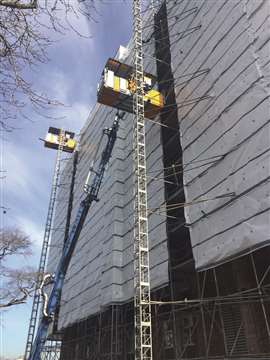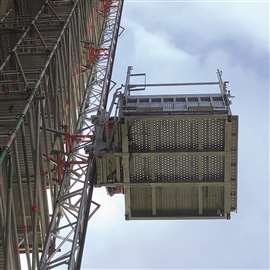Regulations and standards
June 09, 2023
The Scaffold & Access Industry Association (SAIA) has announced the 2023 ASC A92 Main Committee Meeting will take place from Nov. 6-9 at the Westin Kansas City at Crown Center.

The meeting is open to anyone who has an interest in the standards that establish consensus (industry) rules, guidelines or characteristics for activities or their results in the aerial platforms industry.
Consensus (industry) standards are voluntarily used by manufacturers, dealers, owners, users, and operators of mobile elevating work platforms (MEWP). The purpose of the standards is the prevention of accidents and injuries as well as establishing criteria for the manufacturers. The standards also aid the manufacturers, dealers, owners, users, and operators of the platforms to understand their various responsibilities.
The SAIA’s role
For more than 35 years, the SAIA has been developing safety guides for the aerial platform industry. The SAIA serves as the Secretariat for the A92 series of standards and is responsible for adhering to the policies and procedures outlined in the ANSI Essential Requirements, which govern the consensus development process.
 The approved transport platform standards applies to TPs that are primarily used as a tool of the trade to vertically transport authorized persons and materials. (Photo: Beta Max)
The approved transport platform standards applies to TPs that are primarily used as a tool of the trade to vertically transport authorized persons and materials. (Photo: Beta Max)
Standards Managed and Maintained by the ASC A92 include:
- ANSI/SAIA A92.2-2021 for Vehicle-Mounted Rotating and Elevating Work Platforms
- ANSI/SAIA A92.7-2014 for Airline Ground Support Vehicle-Mounted Vertical Lift Devices
- ANSI/SAIA A92.9-2023 for Mast-Climbing Work Platforms
- ANSI/SAIA A92.10-2023 for Transport Platforms
The A92 Suite of Standards Includes:
- ANSI/SAIA A92.20-2021: Design, Calculations, Safety Requirements and Test Methods for Mobile Elevating Work Platforms (MEWPs)
- ANSI/SAIA A92.22-2021: Safe Use of Mobile Elevating Work Platforms (MEWPs)
- ANSI/SAIA A92.24-2018: Training Requirements for the Use, Operation, Inspection, Testing and Maintenance of Mobile Elevating Work Platforms (MEWPs)
The suite of standards, which incorporate performance criteria rather than product-specific, replaced the standards listed below that were administratively withdrawn from ANSI on June 1, 2020.
- ANSI/SAIA A92.3-2006 (R2014) for Manually Propelled Elevating Aerial Platforms
- ANSI/SAIA A92.5-2006 (R2014) for Boom-Supported Elevating Work Platforms
- ANSI/SAIA A92.6-2006 (R2014) for Self-Propelled Elevating Work Platforms
- ANSI/SAIA A92.8-2006 (R2011) for Vehicle-Mounted Bridge Inspection and Maintenance Devices
AN92 updates and news
Over the last two years, the American National Standards Institute (ANSI) has approved major changes to the suite of A92 standards. Earlier this year, the Scaffold & Access Industry Association (SAIA) announced that the ANSI Board of Standards Review has approved the following action in connection with two candidate American National Standards:
- Notification on Final Action on: ANSI/SAIA A92.9-2023 Mast-Climbing Work Platforms (revision of ANSI/SAIA A92.9-2011 (R2017)) Approval Date of Final Action: 2/6/2023 Effective Date: March 1, 2024
- Notification on Final Action on: ANSI/SAIA A92.10-2023 Transport Platforms (revision of ANSI/SAIA A92.10-2009 (R2014)) Approval Date of Final Action: 2/10/2023 Effective Date: March 1, 2024
The standard applies to Transport Platforms that are primarily used as a tool of the trade to vertically transport authorized persons, along with materials and necessary tools, to various access levels on a building or structure for construction, renovation, maintenance, or other types of work. Some of the key requirements of this standard include, but are not limited to the following:
- Only authorized persons as defined by this Standard are permitted to be on the Transport Platform. The authorized persons shall have the necessary knowledge or experience or shall have received training prior to being on the Transport Platform. As a minimum, the training for Transport Platforms shall be the same as training requirements for scaffolds as set out in OSHA-CFR Subpart L, Scaffolds – 1926.454-Training Requirements.
- The maximum number of authorized persons permitted on the platform shall be limited to the number equaling no more than 50% of the platform-rated load capacity at 200 lbs per person.
- The maximum vertical travel speed of the Transport Platform shall not exceed 40ft/min (12m/min);
- The Transport Platform shall operate at a safe minimum travel distance of 18in (.46m) from the building or structure;
- The Transport Platform shall be operated from controls located on the platform by an authorized person trained by a competent person.
 The ANSI Board of Standards Review approved two transport platform standards earlier this year. (Photo: Alimak)
The ANSI Board of Standards Review approved two transport platform standards earlier this year. (Photo: Alimak)
In late 2021, ANSI also approved A92 standards for for the design, safe use and training for the use of MEWPs. ANSI standards are voluntary; however, they are considered industry best practices.
The Design standard (ANSI A92.20) provides manufacturers and others with standards for the design of equipment manufactured after the standard’s compliance date. It does not impact equipment manufactured prior to the date of implementation. The remaining two standards are the Safe Use standard (ANSI A92.22) and the Training standard (ANSI A92.24). Both of these standards assist users, operators, owners, etc. in understanding and applying safe use practices and ensuring training to support safe use. Compliance dates vary for the three standards as discussed below, but as of August 15, 2021, all three standards are in effect.
The standards cover most aspects of MEWP design and use, including an update to the terminology used for aerial work platforms (referred to in the ANSI A92 standards as MEWPs). This terminology aids in making the ANSI A92 standards more consistent with other standards.
For more information on any of the ANSI A92 Standards, visit www.saiaonline.org/ansi.
Schedule of ASC A92 events
Here’s a rundown of the ASC A92 Main Committee Meeting’s schedule:
Monday, Nov. 6
7 a.m. – 8 a.m. – Breakfast
7 a.m. – 5 p.m. – SAIA information desk and registration available
8 a.m. – noon – A92.2 subcommittee meeting
Noon – 1 p.m. – Lunch
1 p.m. – 5 p.m. – A92.24 Subcommittee meeting
5 p.m. – 7 p.m. – AEM MEWPC engineering meeting
Tuesday, Nov. 7
7 a.m. – 8 a.m. – Breakfast
7 a.m. – 5 p.m. – SAIA information desk and registration available
8 a.m. – noon – A92.2 subcommittee meeting
8 a.m. – noon – A92.9 (design) subcommittee meeting
Noon – 1 p.m. – Lunch
1 p.m. – 5 p.m. – A92.9 (safe use and training) subcommittee meeting
1 p.m. – 5 p.m. – A92.22 subcommittee meeting
1 p.m. – 5 p.m. – AEM MADDDC engineering committee
5:15 p.m. – 6:30 p.m. – MEWP Council meeting
Wednesday, Nov. 8
7 a.m. – 8 a.m. – Breakfast
7 a.m. – 5 p.m. – SAIA information desk and registration available
8 a.m. – noon – A92.24 subcommittee meeting
8 a.m. – noon – A92.1 (design) subcommittee meeting
Noon – 1 p.m. – Lunch
1 p.m. – 5 p.m. – A92.7 subcommittee meeting
Thursday, Nov. 9
7 a.m. – 8 a.m. – Breakfast
7 a.m. – noon – SAIA information desk and registration available
8 a.m. – noon – A92 main committee meeting
1 p.m. – 3 p.m. – ISO/TC 214 U.S. Technical Advisory Group (TAG)
For more information or to register for the meeting, visit the SAIA website here.
Are you conforming?
 Over the past two years, ANSI has approved major changes to the suite of A92 standards. (Photo: Adobe)
Over the past two years, ANSI has approved major changes to the suite of A92 standards. (Photo: Adobe)
Standardization and conformity assessment activities lead to lower costs by reducing redundancy, minimizing errors, and reducing time to the market. Demonstrating compliance with standards helps your products, services, and personnel to cross borders. Standards also make cross-border interoperability possible, ensuring that products manufactured in one country can be sold and used in another.
Your business can reduce the economic risk of research and development activities by participating in standardization. You can lower overall research and development costs by relying on previously standardized technologies and terminologies.
The best advice: know the standard that affects the aerial platform equipment you are manufacturing, renting, selling, owning or using. The A92 series of standards outline your responsibilities.
STAY CONNECTED



Receive the information you need when you need it through our world-leading magazines, newsletters and daily briefings.
CONNECT WITH THE TEAM







